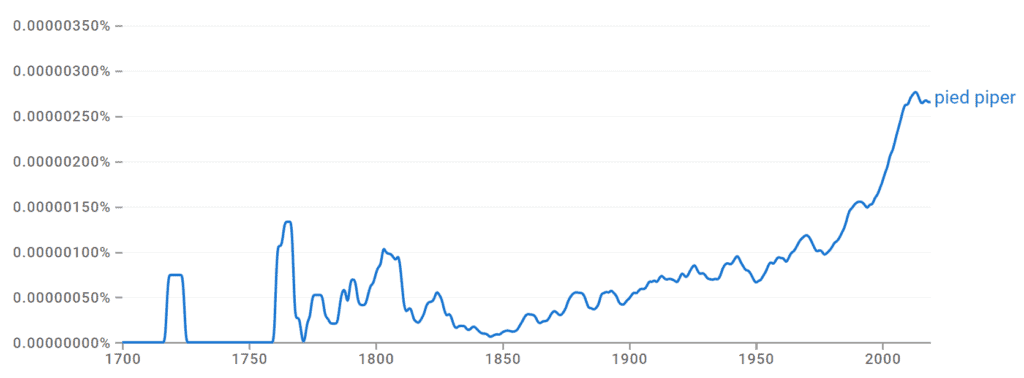When it’s time to face the consequences of your decisions, you may have heard somebody tell you it’s time to pay the piper.
Paying the piper is an old term, revived by a 19th-century poet but dating back much further. Its sad yet interesting origins are said to stem from a German fairy tale first recorded by the Grimm brothers. But, even their sources were simply sharing older historical stories from the region.
Let’s take a closer look at the origins of this idiom and how to use it in the modern context.
What Does Pay the Piper Mean?
When it is time to pay the piper, it is time to accept the consequences of thoughtless or rash action. The phrase can also mean it is time to fulfill a responsibility or promise, usually after the fulfillment has already been delayed.
The phrase is almost always used with a pejorative connotation or a phrase that creates a negative tone – often used to disparage or belittle in its context.
For example:
- Sarah sat with her arms crossed, glaring at her parents as they demanded she finishes the semester they had paid for; she knew the time would come to pay the piper, but she had wrongly assumed the semester would end before the day arrived.
As a phrase, the verb is conjugated through all its forms, i.e., paid the piper or paying the piper.
A related phrase is “he who pays the piper calls the tune.” This is somewhat self-explanatory and means that the one who is footing the bill gets to make the decisions. This is sometimes used to mean that the wealthy have all the power.
For example:
- Jon looked at Alyssa, “I’m not sure why you are upset at the decision since you always knew he who pays the piper would call the rules of the game.”
Pay the piper is an idiom, meaning the words combined mean something very different than their literal connotation. When you use the term, you are creating an analogy or connection to another meaning.
Even though many people use idioms because they know their figurative definitions, many are unaware of where they originated from. Sometimes the histories of idioms are dull and boring, but occasionally, they seep into cultural myths, such as this one. Let’s pay closer attention to this term’s history, so you understand its entire context.
Pay the Piper Origins
The phrase comes from the fable of the Pied Piper of Hamelin. According to the myth, a piper was hired to clear out the rats from the village of Hamelin (pied refers to the black and white coloring of the magpie, a common black-and-white bird of the crow family). After he did so by playing a song and luring them away, he was not paid for his work. His revenge for the lack of payment was to steal all the town’s children. The moral of the story was to pay the piper and keep up your half of the bargain lest you lose what is important to you.
But where did this story originate? The Grimms brothers were fascinated with folklore and traveled through Europe during the 19th century, collecting over 200 stories in more than 40 years. They published these retellings in their canon, Grimm’s Fairy Tales (originally called Children’s and Household Tales), and other various short collections.
The Tale of the Pied Piper
The story of the Pied Piper of Hamelin was one of the tales found in the Grimm’s collections, but what many people don’t realize is that a historical context of some sort often influences folklore. This doesn’t mean that the supernatural aspects of these stories actually happened, but that through the attempts to explain events and the retellings through the years. These tales can provide us a glimpse into the people living during the times these stories began to be told.
If you were to travel to the town of Hamelin today, the history of this story is literally etched into the buildings of Hamelin itself. In the middle ages, Hamelin was one of many German towns that depended on commerce for survival, and the mystery of the Pied Piper is explained on a plaque set on a residence dated back to 1602. There is even an earlier account etched onto one of the building’s windows.
“A.D. 1284 – on the 26th of June – the day of St John and St Paul – 130 children – born in Hamelin – were led out of the town by a piper wearing multicoloured clothes. After passing the Calvary near the Koppenberg they disappeared forever.”
There is also a town record that dates back to 1384 in reference to the “100 years since our children left.” Reports of a stained glass window in the church showing the Pied Piper leading away children are also spoken of, but the church was destroyed in the 17th century.
A 15th-century manuscript and memory verses all refer to the same story as well, likely acting as a major source for the Grimm brothers as they traveled the region documenting such tales.
The Modern Origins of Pay the Piper
The term, pay the piper, was brought to the attention of the masses in Robert Browning’s 1849 poem, The Pied Piper of Hamelin, influenced by the Brothers Grimm’s retelling of the tale. In the poem, Browning tells the tale with a poetic flair. It was widely read, and the idiomatic phrase to pay the piper came into use.
Let’s Review
When it’s time to pay the piper, it means it’s time you take responsibility for your actions. Usually, it has a connotative meaning to suggest you’ve been irresponsible in some manner.
The idiom has long been used after the story’s retelling in poetic form during the 19th century, but its long and illustrious history is actively influenced by a tragedy that befell the German town of Hamelin in 1284, in which 130 children were lost forever.


